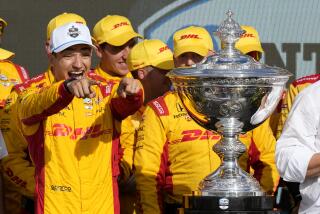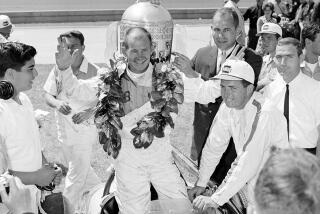Elliott Completes Daytona Sweep
DAYTONA BEACH, Fla.--Bobby Allison was saying before the Daytona 500 that if nothing went wrong with Bill Elliott’s car, the only way to stop him would be to shoot him.
Allison was right. Nothing went wrong, nobody shot him, and the youthful Good Ol’ Boy from Dawsonville, Ga., won his first Daytona 500 before 150,000 spectators Sunday in a manner rarely seen at Daytona International Speedway, or any other place where NASCAR Grand National stock cars run.
Elliott, in a red Ford Thunderbird owned by Harry Melling of Jackson, Mich., sponsored by Coors and prepared by his brother Ernie Elliott, led 137 of the 200 laps and except for an early 32 laps when two-time defending champion Cale Yarborough led in another T-Bird, Elliott appeared to be toying with the rest of the 40-car field.
After Yarborough’s orange Ford slowed and crawled into the pits on lap 62, the only time Elliott gave up the lead was when he was content to cruise along behind Neil Bonnett for about 20 laps or when he took an extremely long pit stop while brother Ernie taped up a loose headlight mounting.
The only other car on the same lap with Elliott at the finish was Lake Speed, a former kart-racing champion from Jackson, Miss., who had never finished higher than third in 113 Grand National races. Elliott’s winning margin over Speed was only seven car lengths, but this is misleading. If Dave Marcis hadn’t stalled in Turn 1 late in the race, Elliott might have lapped the field. At the time Elliott had a 28 second lead--more than halfway around the 2.5-mile tri-oval--and he was stretching his margin with every lap.
In Thursday’s 125-mile qualifying race, Elliott won by 37 seconds. Elliott became only the third driver in 27 years to sweep Daytona, winning the pole, a qualifying heat and the 500. The others were Fireball Roberts in 1963 and Yarborough last year.
“We came down here from day one and everything just went together,” Elliott said as his wife Martha and 7-year-old daughter Starr smiled in the winner’s circle. “We worked so hard and were so prepared, I think it may have made some of the others more disorganized when they saw us.
“If I never win another race, I’ve accomplished my main goal. Winning Daytona has been my goal since we came down here in 1977 and didn’t make the field. I felt awful when we had to load up and go home with nothing for it. This makes it all worth while.”
Elliott was setting speed records at every lap until four caution flag periods in the final 35 laps slowed the winning speed to 172.265 m.p.h, well below the record 177.602 by Buddy Baker in 1980.
The first of the four came about when Marcis stalled and a tow truck was dispatched to haul him to the garage. This enabled Bonnett and Speed, the only drivers on the same lap, to close up behind Elliott. Bonnett, capitalizing on his good fortune, swept past Elliott when the green flag came out and held the lead until Dick Brooks brushed the wall and lost a wheel on lap 172, bringing out yet another caution flag.
Both Bonnett and Elliott came in together for tires and fuel, but Elliott won the race out of the pits and quickly built up a substantial lead, only to lose it when Lennie Pond spun on the front straightaway.
Even though only eight laps remained, Elliott ducked into pit row for a complete set of new tires--his second set in 18 laps. Bonnett faked as if to come in behind Elliott, but just as he reached the pit entrance he veered back onto the track and took the lead.
Six laps remained when the green flag came out, setting up a shootout between the fastest Ford and the fastest Chevy. Elliott had won the pole with a record 205.114 m.p.h. lap a week ago, while Bonnett’s Chevy was best in class at 202.584.
Elliott used a draft from Bonnett’s car to pull in front before a lap had been completed, but for all intents and purposes the race ended on lap 195. Bonnett was pressuring Elliott when the engine let go in his Chevy and when the oil hit his tires it sent the car spinning into the infield.
“Something in the engine came loose,” Bonnett said. “Tim (crew chief Tim Brewer) and I figured Elliott could beat me anyway, which is why we didn’t stop for tires on that last caution when Elliott did. We figured maybe if he would get held up, or something, we would get lucky.”
After Bonnett’s mess was cleaned up, race officials brought out the green flag for one lap to the checkered flag. Speed posed no challenge to Elliott, but Speed had second place clinched because every other driver was a lap or more behind--or sitting behind the wall with their cars parked.
Darrell Waltrip, Bonnett’s Junior Johnson teammate, finished third after losing a lap early in the race when his car had handling problems. Buddy Baker was fourth, Ricky Rudd fifth and Greg Sacks, driving the car in which Yarborough won the 1984 Daytona 500, was a surprising sixth.
“It just goes to show what a guy can do with a good car,” said Sacks, who had never finished higher than ninth since he joined NASCAR in 1983.
As long as Yarborough was in the race, he and Elliott traded the lead back and forth six times in a dizzying display of speed that took its toll first of Yarborough, then most of the other name drivers in the race.
“I thought if Bill and I stayed together I had a good shot at winning that third 500 in a row, but I don’t think anyone else had a shot at him,” Yarborough said. “Bill and I were very equal out there. He could go to the front when he wanted and I could pass him when I wanted. It would have been some shootout, him wanting his first 500 win and me wanting my third. Boy, what a disappointment.”
Yarborough’s problem was apparently caused when he ran out of gas on lap 62 just beyond the pit entrance and had to coax his car all around the track before reaching the Ranier team pits.
“When you run the fuel down that low, you usually burn a piston,” crew chief Waddell Wilson said. “That’s what I think happened. The engine just froze up.”
In the eight laps between 83 and 91, the drivers who pulled off the track and turned left into the garage area looked like a Hall of Fame roster.
Bobby Allison, running second at the time, pulled behind the wall after a puff of smoke from his engine told him something was amiss. Right behind him was Richard Petty, crawling slowly along the apron with a broken clutch. A lap later Benny Parsons came in with a burned piston, followed by Dale Earnhardt.
“Everyone said they thought they saw my engine smoking,” Earnhardt said. “It wasn’t. The car was so hard to handle, what they saw was my elbows working so hard to hold it.”
Next to call it a day were the two 50-year-olds, A. J. Foyt and David Pearson. They, too, succumbed to burned pistons.
At the time each fell out, they were running second or third, pushing their cars beyond their mechanical limits in a futile attempt to reel in the flying Elliott.
Running second continued to be a jinx as another burned piston sidelined Harry Gant after he assumed the runner-up role on lap 125, and then Bonnett was next when he spun in his own oil on lap 195.
The win, worth $185,500 to Elliott, was only his fourth in Winston Cup racing. It took the Elliotts eight seasons of racing Fords before Bill won his first race, the 1983 Winston Western 500 at Riverside International Raceway. Last year he won three races, including two of the final five.
Although Melling, a tool manufacturer, owns the team, the Elliott Racing Team is a family operation. Ernie builds the engines, Bill sets up the chassis and drives, Dan assists his brother Ernie in the engine room and father George oversees the operation in their north Georgia hometown of Dawsonville.
In a day when the Good Ol’ Boys of racing, men who learned their trade hauling bootleg whiskey through back country roads, are phasing out with age, the Elliotts are a refreshing throwback to that era.
“Where I come from used to be known as the moonshine part of the state,” Bill said proudly. “I never did drink any of the stuff, I used it in the car for fuel.
“Things have changed a lot in Dawsonville since I was growing up. There’s about 800 people living there now, with another 5,000 in Dawson County. Ernie’s older, and when he was a teen-ager, he’d race through the streets. A good bit of what Ernie knows about motors now he learned back from those days when the cars used to race around the courthouse square, or race from Dawsonville to Dahlonaga.
“Ernie would put a race motor in the family car and go out and whip everybody drag racing through the center of town. One guy would run through town real quick and the law would take out after him. While he was gone the cars would pull up and stop, passengers would jump out of the cars and away they’d go racing. It was something to see, but I never did that. By the time I was old enough, the law got radios and road blocks, and things like that.”
The engine that Ernie put in the Coors car was definitely the strongest Sunday, but Bill claims he has no idea where his brother found the horsepower secret the other engine builders apparently haven’t found.
“The motor department is in one building at our shop and the cars are in another,” Bill explained. “I don’t ask him about how much horsepower or whatever we have. He just gives me good motors and I work on the chassis and the system seems to be working right now.”
Bill, 29, and the first driver under 30 to win at Daytona since Pete Hamilton in 1970, was asked if he thought he might be carrying on the Good Ol’ Boy tradition in stock car racing.
“I sure hope so,” he said, his blue eyes gleaming. “That’d make me and my daddy both real proud.”
More to Read
Go beyond the scoreboard
Get the latest on L.A.'s teams in the daily Sports Report newsletter.
You may occasionally receive promotional content from the Los Angeles Times.










